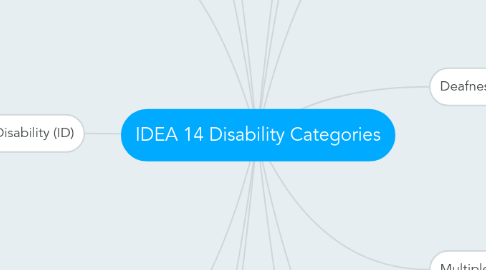IDEA 14 Disability Categories
by Jaya Ramchandani

1. Specific Learning Disability (SLD)
1.1. A disorder in one or more of the basic psychological processes involved in understanding or in using language, spoken or written, that may manifest itself in the imperfect ability to listen, think, speak, read, write, spell, or to do mathematical calculations.
1.2. Intervention/Accommodation: http://ldaamerica.org/accommodations-techniques-and-aids-for-learning/
1.3. Assistive Technology: http://www.readingrockets.org/article/assistive-technology-kids-learning-disabilities-overview
2. Developmental Delay (DD)
2.1. For children from birth to age three and children from ages three through nine, the term developmental delay, as defined by each State, means a delay in one or more of the following areas: physical development; cognitive development; communication; social or emotional development; or adaptive (behavioral) development.
2.2. Intervention/Accomodation: http://do2learn.com/disabilities/CharacteristicsAndStrategies/DevelopmentalDelay_Strategies.html
2.3. Assistive Technology: https://www.youtube.com/watch?v=NkDf2mXBj1Y
3. Emotional Disturbance (ED)
3.1. A condition exhibiting one or more of the following characteristics over a long period of time and to a marked degree that adversely affects a child’s educational performance.
3.2. Intervention/Accommodation: https://www.youtube.com/watch?v=q-t2HStIGk8
3.3. Assistive Technology: https://www.youtube.com/watch?v=q-t2HStIGk8
3.4. Case Study: http://images.pearsonassessments.com/images/ca/rti/downloads/Megan.pdf
4. Intellectual Disability (ID)
4.1. Significantly sub average general intellectual functioning, existing concurrently with deficits in adaptive behavior and manifested during the developmental period, that adversely affects a child’s educational performance.
4.2. Intervention/Accommodation: http://www.brighthubeducation.com/special-ed-learning-disorders/104639-modificatons-for-students-with-intellectual-disabilities/
4.3. Assistive Technology: https://www.disability.gov/resource/assistive-technology-individuals-intellectual-developmental-disabilities/
4.4. Case Study: http://www.parentcenterhub.org/repository/intellectual/
5. Other Health Impairment (OHI)
5.1. Having limited strength, vitality, or alertness, including a heightened alertness to environmental stimuli, that results in limited alertness with respect to the educational environment.
5.2. Intervention/Accommodation: 1. physical independence, including mastery of daily living skills 2. self-awareness and social maturation 3. communication 4. academic growth 5. life skills training
5.3. Assistive Technology: For the most part, the majority of these students can access and benefit from the same technological supports that are used with their normally developing peers.
6. Speech or Language Impairment
6.1. A communication disorder such as stuttering, impaired articulation, a language impairment, or a voice impairment that adversely affects a child’s educational performance.
6.2. Intervention/Accommodation: http://do2learn.com/disabilities/CharacteristicsAndStrategies/SpeechLanguageImpairment_Strategies.html
6.3. Assistive Technology: http://www.projectidealonline.org/v/speech-language-impairments/
7. Visual Impairment Including Blindness
7.1. An impairment in vision that, even with correction, adversely affects a child’s educational performance.
7.2. Intervention/Accommodation: http://www.teachingvisuallyimpaired.com/accommodations.html
7.3. Assistive Technology: http://www.teachingvisuallyimpaired.com/assistive-technology.html
8. Autism
8.1. A developmental disability significantly affecting verbal and nonverbal communication and social interaction, generally evident before age three, that adversely affects a child’s educational performance.
8.2. Intervention/Accommodation: http://www.learnnc.org/lp/editions/every-learner/6692
8.3. Assistive Technology: https://www.cesa7.org/sped/autism/assist/asst10.htm
9. Hearing Impairment
9.1. An impairment in hearing, whether permanent or fluctuating, that adversely affects a child’s educational performance.
9.2. Intervention/Accommodation: http://www.usf.edu/student-affairs/student-disabilities-services/accommodations/hearing-impaired.aspx
9.3. Assistive Technology: http://successforkidswithhearingloss.com/issues-technology-accommodations/
10. Deaf-Blindness
10.1. Simultaneous hearing and visual impairments, the combination of which causes such severe communication and other developmental and educational needs that they cannot be accommodated in special education programs solely for children with deafness or children with blindness.
10.2. Intervention/Accommodation: http://www.deafblindinfo.org/tools.html
10.3. Assistive Technology: https://nationaldb.org/library/list/40
10.4. Case Study: http://www.tcnj.edu/~technj/2006/deafblind.htm
11. Deafness
11.1. A hearing impairment so severe that a child is impaired in processing linguistic information through hearing, with or without amplification, that adversely affects a child’s educational performance.
11.2. Intervention/Accomodation: http://successforkidswithhearingloss.com/relationship-hl-listen-learn/accommodations
11.3. Assistive Technology: http://successforkidswithhearingloss.com/relationship-hl-listen-learn/accommodations
12. Multiple Disabilities
12.1. Simultaneous impairments (such as intellectual disability-blindness, intellectual disability-orthopedic impairment, etc.), the combination of which causes such severe educational needs that they cannot be accommodated in a special education program solely for one of the impairments.
12.2. Intervention/Accommodation: https://www.youtube.com/watch?v=DhCDtFE8JMQ
12.3. Assistive Technology: http://www.pathstoliteracy.org/technology-students-multiple-disabilities
13. Orthopedic Impairment
13.1. A severe orthopedic impairment that adversely affects a child’s educational performance.
13.2. Intervention/Accommodation: http://orthopedicimpairments.weebly.com/for-teachers.html
13.3. Assistive Technology: http://www.projectidealonline.org/v/orthopedic-impairments/
14. Traumatic Brain Injury
14.1. An acquired injury to the brain caused by an external physical force, resulting in total or partial functional disability or psychosocial impairment, or both, that adversely affects a child’s educational performance.
14.2. Intervention/Accommodation: Provide external devices and cues that the student can use to compensate for organization, memory, and motor deficits
14.3. Assistive Technology: Assistive devices can include technical equipment and materials such as tape recorders, calculators, electronic spellers, computers or word processors, augmentative communication devices, timers, alarms, and beepers or equipment for mobility.


